by Kathryn Tacke (North Central Regional Economist, Idaho Department of Labor)
Health care is one of the largest and fastest growing sectors in North Central Idaho (the five counties of Clearwater, Idaho, Latah, Lewis, and Nez Perce) and Southeast Washington (the four counties of Asotin, Columbia, Garfield, and Whitman). In 2018, it employed more than 6,800 people on the Idaho side and 3,500 people on the Washington side. Twenty years ago, it employed 4,700 and 1,900. Health care employment in the nine-county region grew 54 percent over those 20 years, while total payroll jobs grew 12 percent.
Of the 8,300 jobs added in the nine counties 1999 and 2018, 3,600 (about 43%) were health care jobs.
That strong growth is expected to continue. Economic Modeling Specialists International (EMSI) projects that the nine counties will add roughly the same number of health care jobs between 2018 and 2028 as they added in the previous 10 years. Health care is expected to grow more than four times faster than total employment.
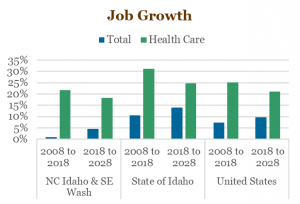
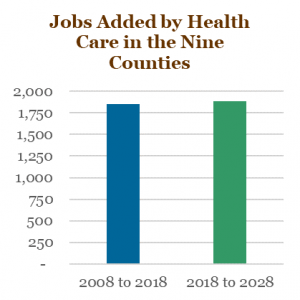
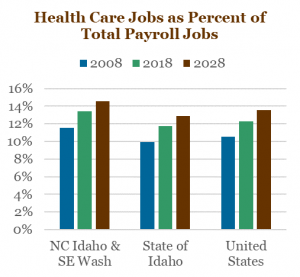
Health care employment has grown as a percentage of total payroll employment and is expected to continue to grow. Health care jobs make up a large percentage of total jobs in the nine-county region than in Idaho or the United States, as the graph on the left shows.
Health care payrolls in North Central Idaho and Southeast Washington totaled $540 million in 2018. The average earnings per health care job was $52,200, higher than the average earnings of $50,130 for all sectors.

Components of Health Care
Ambulatory Health Care includes offices of doctors, dentists, and other health care practitioners; medical laboratories; dialysis centers; and clinics.
Hospitals including the state psychiatric hospital in Orofino.
Nursing & Residential Care includes nursing homes, assisted living, and other residential care.
Services for Elderly & Persons with Disabilities
Population Growth & Aging Drive Health Care Growth
The growth and aging of the region’s population explain much of the growth in health care employment. Between 2008 and 2018, the total population grew 7% from 175,000 to 187,000, while the population 65 years and older grew 29% from 25,800 to 33,400.
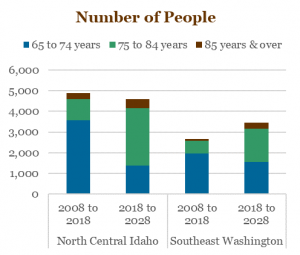
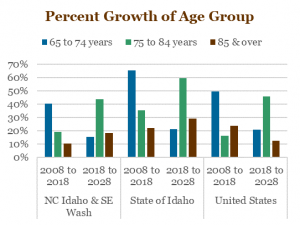
Senior citizens make up an especially high percentage of the population in the nine counties, as the graph below shows:
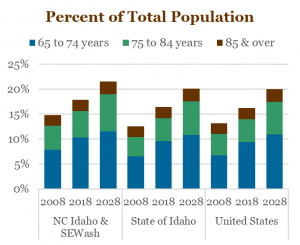
Health Care Occupations Continue to Grow Rapidly
The growth of the health care sector results in the creation of jobs in many occupational categories (including managerial, financial, insurance, food preparation, building maintenance and cleaning, informational technology, and emergency technicians), but especially spurs the growth of health care occupations. In North Central Idaho and Southeast Washington, health care occupations grew 16% from 7,200 in 2008 to 8,400 in 2018, and are projected to grow even faster- 19%- to 10,000 between 2018 and 2028.
Four of the ten occupations expected to add the most jobs in the region are health care occupations. The estimated job openings per year between 2018 and 2028 shown below include only openings caused by growth of the occupation and by replacement needs resulting from retirements and people leaving the occupation. They don’t include the openings caused by people moving within the occupation (i.e.: turnover).
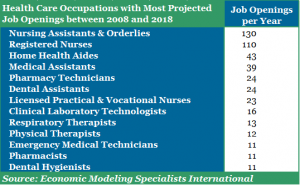
The Challenge of an Aging Workforce
While the aging of the population boosts the demand for health care workers, it also depresses the potential supply of health care workers. The retirement of the baby boom generation (currently between 55 and 73 years old) poses a challenge for the sector. One in four health care workers are over 54 years old. The number of people entering the labor force for the first time is smaller than the number reaching retirement age. In 2018, 2,020 residents celebrated their 16th birthday while 2,280 turned 65.
Number of Region’s Workforce Turning the Age Indicated

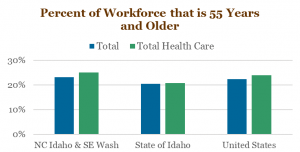
The region’s prime working-age population (25 to 54 years) in 2017 totaled 61,944- down 4% from 2000. It was down 3% in Nez Perce and Asotin Counties, up 5% in Whitman and Latah Counties, and down 22% in the rural counties of Clearwater, Columbia, Garfield, Idaho, and Lewis.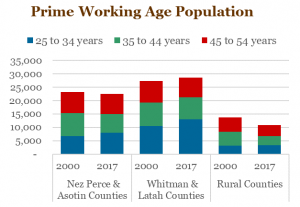

Leave a Reply